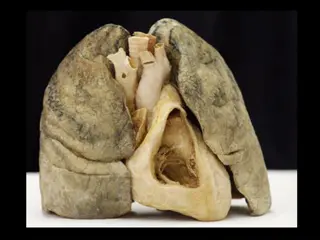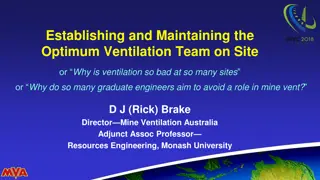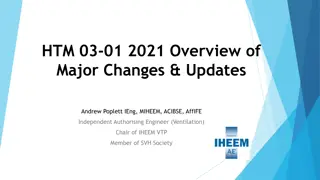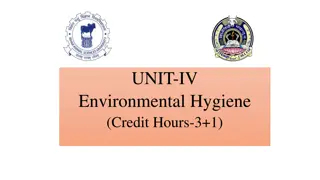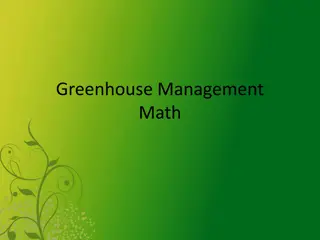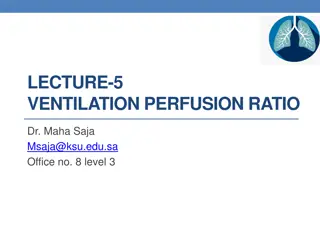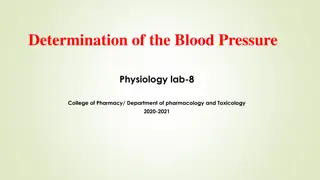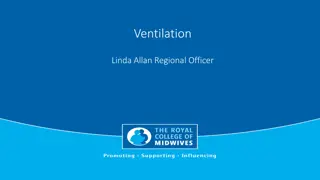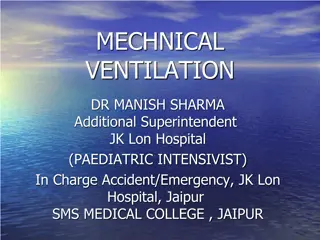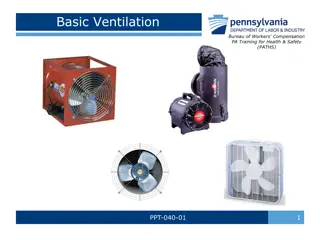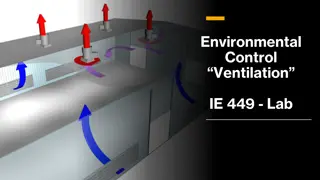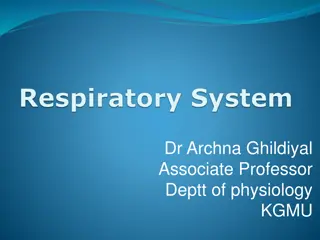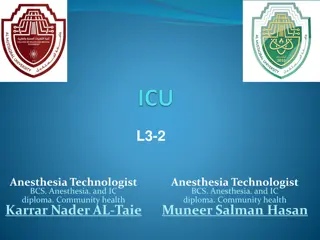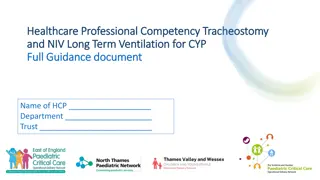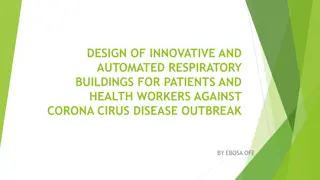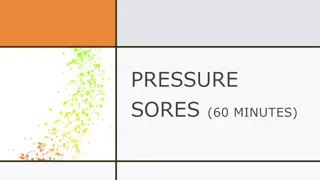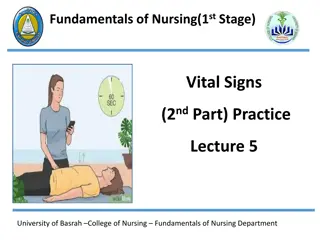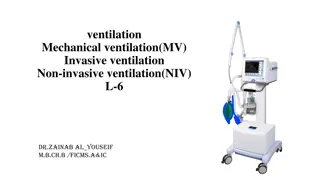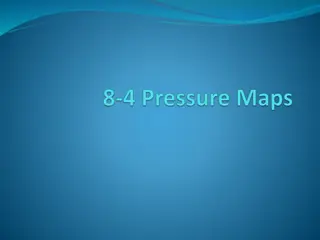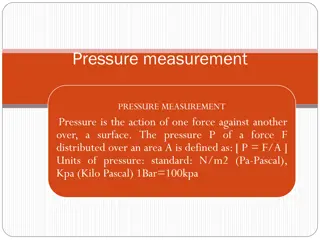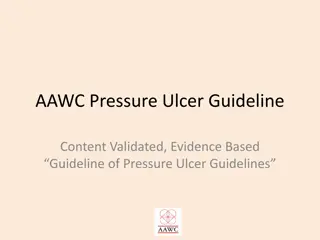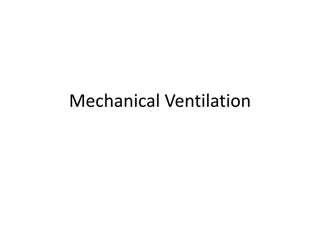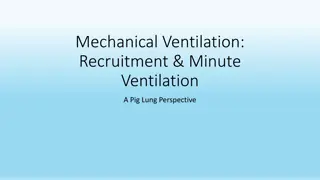Understanding Fluid Pressure in Oil Field Hydraulics
Explore the fundamentals of fluid pressure including pressure basics, unit conversion, fluid weight constants, true vertical depth, and hydrostatic pressure in the context of oil and gas technology programs. Learn how to calculate pressure gradients, understand the impact of fluid density on pressur
1 views • 40 slides
Functions of the Respiratory System and Ventilation Mechanism
The respiratory system performs crucial functions such as ventilation to facilitate gas exchange, maintaining pH balance, and enabling vocal sounds. It consists of the upper and lower respiratory systems, including structures like the nose, trachea, bronchi, and alveoli. The system's epithelium, the
7 views • 43 slides
Overview of Mechanical Ventilation in Critical Care
Discussing the indication, modes, variables, and controls of mechanical ventilation as well as the differences between volume and pressure control. Exploring assist control, synchronized intermittent mandatory ventilation, and other key aspects of ventilator management by Dr. Zia Arshad.
0 views • 22 slides
Enhancing Mine Ventilation for Optimal Performance
Discover the key role of ventilation in mining operations, debunking misconceptions about its importance. Learn how good ventilation practices contribute value to a mine, improve safety, reduce costs, and boost productivity. Explore the crucial considerations in establishing and maintaining an effic
0 views • 26 slides
Overview of HTM 03-01-2021 Major Changes & Updates in Healthcare Ventilation Systems
This overview covers the major changes and updates in healthcare ventilation systems as per HTM 03-01-2021. It emphasizes the shift towards net-zero carbon emissions by 2050, promoting sustainable ventilation practices. Key aspects include the role of Ventilation Safety Groups, derogation processes,
0 views • 21 slides
Proper Ventilation for Animal Houses: Importance and Guidelines
Ventilation in animal houses is crucial for removing stale air and replacing it with fresh air to maintain optimal conditions for animals and their attendants. Improper ventilation can lead to various issues like high humidity, disease spread, and vulnerability to pathogens. This article discusses t
0 views • 12 slides
Greenhouse Management and Temperature Control Guide
Learn about the importance of ventilation and temperature control in greenhouse management, including how to calculate required ventilation and heater size. Understand the benefits of proper ventilation, ways to control greenhouse temperature, and essential considerations for heating. Explore step-b
1 views • 21 slides
Understanding Ventilation-Perfusion Ratio in Pulmonary Circulation
This lecture delves into the intricate relationship between ventilation and perfusion in the lungs, highlighting the importance of proper gas exchange for optimal respiratory function. It discusses the circulations supplying the lungs, defines the V/Q ratio, and explores the clinical significance of
0 views • 25 slides
Influence of Environmental Factors on Sound Pressure Levels
In this study, the relationship between sound pressure, particle velocity, and the acoustic impedance is explored in the context of varying humidity, temperature, and barometric pressure. The ideal gas law is used to determine the density of both dry and humid air, considering parameters such as par
1 views • 14 slides
Measurement Methods for Pressure Evaluation
The content describes the measurement of pressure using various methods such as Bourdon pressure gauge, diaphragm pressure gauge, and McLeod gauge. It explains the principle of McLeod vacuum gauge, the operation of the gauge, and the components involved. The McLeod gauge works by compressing a known
3 views • 27 slides
Understanding Horizontal Distribution of Air Pressure and Pressure Belts on the Globe
The horizontal distribution of air pressure and pressure belts on Earth is characterized by isobars, indicative of high and low pressure systems. The regular zonal distribution of pressure belts is affected by the uneven distribution of land and water. Pressure belts are not solely induced by temper
1 views • 7 slides
Understanding Blood Pressure Physiology in a Lab Setting
Blood pressure (BP) is the lateral pressure exerted by the column of blood on the artery wall. This lab aims to determine BP at rest and after exercise using a sphygmomanometer and stethoscope. Learn about systolic and diastolic pressures, pulse pressure, and mean arterial pressure. Methods include
1 views • 17 slides
Understanding Pressure Measurement and Hydrostatic Forces on Surfaces
Measurement of pressure using various gauges like Bourdon and Diaphragm Gauge, different types of pressure gauges like Bellows and Dead Weight Pressure Gauge are discussed. Piezometer and different types of manometers for pressure measurement are also explained. Additionally, the concept of hydrosta
2 views • 11 slides
Importance of Ventilation in the Workplace Environment
Adequate ventilation plays a crucial role in reducing the risk of virus transmission, particularly aerosols, in enclosed areas like workplaces. This presentation highlights the significance of ventilation and how health and safety representatives can collaborate to address concerns. It also discusse
1 views • 20 slides
Understanding Mechanical Ventilation in Critical Care Environments
Mechanical ventilation, overseen by Dr. Manish Sharma, Pediatric Intensivist at JK Lon Hospital, Jaipur, is essential for treating respiratory failure. It involves using ventilators to deliver gas to the lungs and meet specific goals like correcting hypoxemia and hypercapnia. This process requires u
0 views • 55 slides
Understanding Pressure in Physics and Daily Life
Explore the concepts of force, pressure, and liquid pressure in physics, and how they relate to daily life scenarios. Learn about the relationship between force and pressure, the effects of surface area on pressure, and the application of pressure in everyday objects. Discover the significance of li
0 views • 13 slides
Colligative Properties in Solutions: Vapor Pressure, Freezing Point Depression, and Osmotic Pressure
Colligative properties such as vapor pressure lowering, freezing point depression, and osmotic pressure are characteristics of solutions that depend on the number of solute particles present. This text explores how these properties are related to the concentration of solute in a solution and how the
0 views • 14 slides
Understanding Pressure and Designing Objects to Alter It
Pressure is a crucial aspect of physics, and this content delves into the concept by comparing scenarios where a woman in stiletto heels or an elephant exerts pressure on the ground. It explains pressure calculation, discusses how objects designed to decrease or increase pressure work, and challenge
0 views • 22 slides
Basic Ventilation Training for Health & Safety
This training presentation covers the basic concepts of ventilation, including reasons for ventilation, proper techniques, student objectives, types of ventilation, methods of ventilation, and ventilation safety precautions. Ventilation is crucial for maintaining high-quality indoor air, removing un
5 views • 22 slides
Insights from CO2 Measurement in Classroom Ventilation
Understand the significance of CO2 measurements in classroom ventilation for better indoor air quality and reduced infection risks. Explore the use of CO2 sensors, data analysis, and proxy models to improve ventilation systems in schools. Discover findings on airborne infection risk and variations w
2 views • 9 slides
Understanding Hydrostatic Pressure in Fluid Statics
Explore the distribution of hydrostatic pressure in static fluids and its influence on solid surfaces, floating bodies, and submerged bodies. Learn about the equilibrium between pressure gradient and gravity force, along with concepts like gage pressure and vacuum. Discover how pressure varies in fl
0 views • 24 slides
Understanding Barometric Pressure and Its Impact on Altitude
Barometric pressure, also known as atmospheric pressure, is the force exerted by the weight of air on a specific area and varies with altitude. This pressure is crucial in various industries, such as cement production at high altitudes. Learn about how to calculate barometric pressure, its relation
0 views • 37 slides
Understanding Blood Pressure Monitoring
Blood pressure monitoring is essential for maintaining overall health. This article explores the significance of blood pressure, the importance of monitoring it, and the methods used to measure blood pressure. It also delves into the clinical need for accurate blood pressure monitoring devices and t
0 views • 22 slides
Understanding Industrial Ventilation Systems for Workplace Safety
Ventilation plays a crucial role in maintaining a safe working environment by providing fresh air, controlling contaminants, and reducing health risks for workers. This article covers the importance of ventilation, areas at risk of deficiency, components of industrial systems, types of ventilation s
0 views • 18 slides
Mechanics of Pulmonary Ventilation and Respiratory Cycle Explained
Understanding the mechanics of pulmonary ventilation is crucial for comprehending the breathing process. This comprehensive overview covers the role of muscles, ribs, pressure changes in alveolar, pleural, and transpulmonary regions, terms related to breathing and ventilation, and the contraction an
0 views • 31 slides
Understanding Mechanical Ventilation in Anesthesia Practice
Anesthesia technologists play a crucial role in managing artificial ventilation, including concepts like Invasive Positive Mechanical Ventilation (IPMV), Fraction of Inspired Oxygen (FIO2), Tidal Volume (VT), Peak Flow Rate, Respiratory Rate, Minute Volume (VE), I:E Ratio, and more. They monitor and
0 views • 27 slides
Healthcare Professional Competency: Tracheostomy and Long-Term Ventilation for Children and Young People
This document provides guidance for healthcare professionals caring for children and young people requiring tracheostomy and long-term ventilation. Developed by experts in pediatric care, the competencies cover essential skills and knowledge necessary for safe and effective patient care outside tert
0 views • 16 slides
Innovative Automated Respiratory Buildings for Corona Virus Outbreak
Ebosa Ofe presents a pioneering design of automated respiratory buildings aimed at safeguarding patients and health workers against the Corona virus outbreak. The buildings utilize advanced ventilation systems to ensure a safe and healthy environment, combating the spread of COVID-19. Explore the co
0 views • 12 slides
Understanding Pressure Sores and Preventive Interventions for Bedridden Patients
Pressure sores, also known as pressure ulcers, are localized areas of tissue necrosis caused by prolonged pressure on skin and soft tissues. This can lead to serious complications, especially in bedridden patients like a 76-year-old man following a stroke. Preventive interventions include relieving
0 views • 26 slides
Understanding Respiratory Rate and Ventilation in Nursing Practice
This lecture focuses on the vital signs related to respiratory rate, emphasizing the three processes of respiration: ventilation, diffusion, and perfusion. Nurses assess ventilation by observing the rate, depth, and rhythm of respiratory movement, crucial in recognizing normal thoracic and abdominal
0 views • 51 slides
Understanding Mechanical Ventilation in Anesthesia Technology
Mechanical ventilation plays a crucial role in assisting patients with breathing difficulties by delivering oxygen and removing carbon dioxide. It involves two primary types: Negative Pressure Ventilation (NPV) and Positive Pressure Ventilation (PPV). NPV helps patients with conditions like chronic
0 views • 19 slides
Ventilation in Critical Care: Basics and Calculations
Understanding mechanical ventilation is crucial in managing critically ill patients. This content covers concepts like I:E ratio, total cycle time calculation, inspiratory and expiratory times, and practical examples. Learn how to adjust ventilator settings based on patient parameters and conditions
0 views • 11 slides
Understanding Air Pressure Through Pressure Maps
Explore the significance of air pressure in understanding weather patterns through pressure maps. Learn to interpret isobars, identify high and low pressure areas, analyze isobar intervals, and understand how air flows from high to low pressure areas. Enhance your meteorological knowledge and grasp
0 views • 6 slides
Understanding Pressure Measurement Techniques
Pressure measurement involves the action of force over a surface. Various sensing elements such as Bourdon tubes, diaphragms, and bellows are utilized for measuring pressure. Bellows sensors are flexible cylindrical enclosures, while Bourdon gauges use coiled tubes for pressure measurement. Differen
0 views • 11 slides
Comprehensive Guide to Pressure Measurement Methods
This comprehensive guide delves into the definition, units, and terminology of pressure measurement, covering low and high-pressure measurement techniques such as McLeod Gauge, Thermal Conductivity Gauge, Ionization Gauge, Manometers, and Electrical Resistance Pressure Gauge. It also explores the re
0 views • 56 slides
AAWC Pressure Ulcer Guideline: Managing Pressure Ulcers Effectively
This content outlines the AAWC Pressure Ulcer Guideline, providing evidence-based recommendations for assessing, preventing, and treating pressure ulcers. The guideline emphasizes the importance of regular skin assessment, personalized care plans, and interdisciplinary wound care management to impro
0 views • 15 slides
Understanding Mechanical Ventilation in COPD Exacerbation
In a case of a 64-year-old woman with COPD exacerbation, managing respiratory distress is crucial. Initiating systemic corticosteroids, doxycycline, and nebulizers while closely monitoring the patient is important. However, in cases where non-invasive ventilation is ineffective, the patient may requ
0 views • 22 slides
Understanding Mechanical Ventilation in a Pig Lung Perspective
Explore recruitment strategies, minute ventilation concepts, and optimization techniques in mechanical ventilation from a unique pig lung perspective. Learn about benefits, recommended PEEP levels, driving pressure, goals of ventilation, and the concept of permissive hypercapnia in respiratory care.
0 views • 14 slides
Temporary Ventilation Project Overview and Challenges
The FE Minute provides an overview of a temporary ventilation project managed by Elisabete Godden, aiming to enhance air flow in classrooms without mechanical ventilation to combat the COVID pandemic. The project involves installing ventilation systems at various spaces within 20 days with a budget
0 views • 14 slides
Design Strategies for Buildings in the UK: A Literature Review
The literature review explores design strategies for buildings in the UK, focusing on ventilation systems, building regulations, and approved document guidelines. Various ventilation systems are discussed, including background ventilators, passive stack ventilation, and mechanical ventilation with h
0 views • 11 slides

